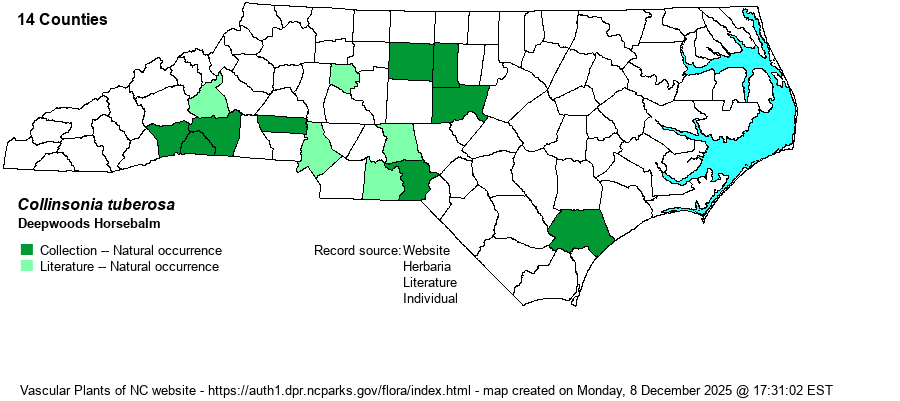| Author | Michaux | |
| Distribution | Widely scattered over most of the Piedmont, north to Alamance, Guilford, and Davie counties, and in the southeastern Mountains. As this species is not known from VA, the species is probably truly absent from the extreme northern Piedmont and northern Mountains. It does not occur in the Coastal Plain, except for a single 1981 specimen at NCU from Harrison's Creek in Pender County, a location known for rich, higher PH soil and other Piedmont disjuncts.
This is a globally scarce species of the Southern states, ranging from central NC and western TN south to southern AL, MS, and LA.
| |
| Abundance | Rare in the southern Piedmont and adjacent southeastern Mountains, from Montgomery and Richmond counties west to McDowell and Henderson counties. Very rare north to Guilford and Davie counties. Specimens at NCU are all prior to 1962, except for Rutherford County (2005, 2011). A single record from the outer Coastal Plain in 1981. This is a Significantly Rare species. The NCNHP has 19 records, but only about half of these are current, and only about one-half dozen are anything other than of poor quality. | |
| Habitat | This is a species that requires high pH soil, in moist and shaded conditions. Thus, most sites are in Basic Mesic Forests, but a few might be in Basic Oak-Hickory Forest or in adjacent rich bottomland forests. |
| Phenology | Blooms from late July to September, and fruits in September and October. | |
| Identification | This is a medium-sized herb, shorter and less robust than the similar C. canadensis, to which it needs to be carefully compared with. Leaves of C. tuberosa are distinctly smaller than those of other Collinsonia species in our state, and the stem and inflorescence branches are more slender. This species is mostly unbranched, growing to about 2 feet tall, with a few pairs of opposite leaves on quite long petioles. Note that the petioles in C. tuberosa are at least half as long as the blade; that is, the petiole averages nearly 2 inches long, and the ovate to elliptic blade is only about 3 inches long and 2 inches wide, with serrated margins. The terminal panicle of scattered flowers in a pyramid shape is about 4-6 inches long, but in this species the flowers are white to cream in color, paler than the canary yellow in C. canadensis. Note that both species can theoretically grow in the same area on the same slope, and bloom at the same time; but this species is quite rare and extremely difficult to find without knowing where to look. Experienced biologists can probably identify the species just in vegetative condition, owing to the long petiole that is generally more than half as long as the length of the blade. In fact, very few people have seen the species in bloom in NC. | |
| Taxonomic Comments | Weakley (2020) mentions that a fairly recent paper concludes that the species should be merged with C. canadensis, but hardly any reference abides by this; however, iNaturalist has this taxon lumped with C. canadensis.
| |
| Other Common Name(s) | Stoneroot, Tuberous Horsebalm | |
| State Rank | S1S2 | |
| Global Rank | G3G4 | |
| State Status | SR-P | |
| US Status | | |
| USACE-agcp | | |
| USACE-emp | | |

